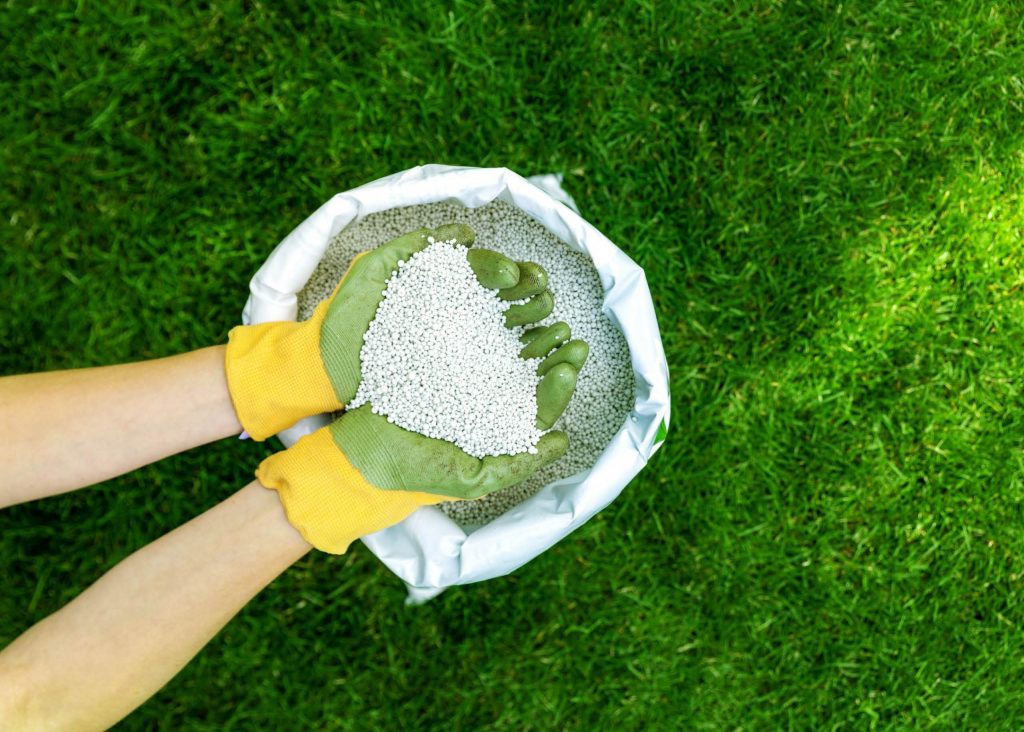Is it Okay to Fertilise Your Lawn After Mowing?
A beautiful, lush lawn is a source of pride for many homeowners. It not only adds to the aesthetics of your property, but also provides a functional space for outdoor ...

Lawn fertilisers are a nutritional staple that assists with the cultivation of a healthy, vibrant lawn and along with regular watering and mowing, form the three building blocks for a patch of grass that’s the envy of the street.
Fertilisers use three basic ingredients as part of their chemistry to stimulate growth and aid plant health – Nitrogen (N), Phosphorus (P) and Potassium (K) which are vital for photosynthesis, cell division and root development. However, they can also contain Iron to enhance colour, Trace Elements to assist with the efficient absorption of the NPK and other organics to improve root and soil health.

While it’s possible for your lawn to survive and grow without regular fertilising, that’s akin to saying that humans could survive on a diet of bread and water alone. Fertilising with a quality, slow-release fertiliser throughout the year ensures that your lawn is never lacking vital nutrients required to thrive, instead of merely surviving.
The most common lawn fertiliser is a ‘granular fertiliser’ that’s spread evenly over the lawn. The granules or ‘prills’ are typically around the size of a match head and will be different colours to signify the different nutrients that make the fertiliser up, mixed with some bright coloured prills to help you track where you’ve spread your fertiliser.
Quality lawn fertilisers will be a combination of Nitrogen, Phosphorus and Potassium, with the ‘NPK’ numbers on the fertiliser packaging stemming from their chemical symbols.
Nitrogen (N) is the element most associated with growth. It’s typically present in the form of Urea, and slow release fertilisers will metre the release of the Urea into the ecosystem by coating it in carbon or a similar material that breaks down slowly. As a rule of thumb, a higher ‘N’ number will translate to faster, more voracious growth but you’ll need to make sure that your lawn is expecting a big ‘N’ kick, and that you’re putting down high Nitrogen fertilisers at the right time of year.
Slower growing varieties like Zoysia won’t need a high Nitrogen fertiliser, and it’s certainly not the fertiliser you’d put down towards the end of the season as ground temps cool down and the plant’s natural growth slows in preparation for winter dormancy.
Phosphorus (P) will typically be the lowest of the three numbers, and it is included for its benefits in root health and plant repair. Your lawn will use less Phosphorus than Nitrogen, hence the disparity between these two numbers and the Nitrogen quantity, but it’s important to balance a lush, healthy canopy of green grass.
Potassium (K) is the final element and one where you’ll see the number vary greatly between fertilisers. Potassium is directly linked to plant resilience, and assists the plant in absorbing Nitrogen. High ‘K’ fertilisers can assist with drought tolerance and increase a lawn’s ability to withstand temperature change, particularly for warm season grasses as their growth naturally slows heading into Autumn and Winter.
There are benefits to fertilising your lawn over and above simply promoting growth and improving colour and condition throughout Spring and Summer.
During the establishment of a new lawn, a quality Starter Fertiliser like Lawn Pride’s Under Turf Starter will provide a lawn with the nutrients vital to thrive after its been freshly laid, but it’s just as important to feed established lawns.
The Phosphorus and Potassium are critical to lawn resilience and will help repair root systems damaged by pests, and combine to help the lawn withstand temperature extremes and other extenuating environmental conditions.
Regularly adding Nitrogen to the lawn in the form of a highly available, controlled release granular fertiliser will also help the lawn generate new growth to repair areas damaged by foot traffic or pets.
Liquid lawn fertilisers are some of the most commonly overlooked and misunderstood supplements in the industry, however they’re quickly taken up by the plant and as a result, can improve the colour and condition of your lawn much quicker than granular products.
Liquid fertilisers are commonly mixed with a carrier solution (typically water) and sprayed on to the leaf of the plant using a handheld or backpack sprayer at a specified rate (in mL) per 100sq.m of lawn.
The supplements in liquid fertilisers aren’t typically slow releasing, nor are the levels as high as those found in granular fertiliser. They’re a great way to spike Nitrogen levels or apply Iron for a quick green up in between granular fertiliser applications, though.
How to apply: Liquid fertilisers can be applied using hose-on packs like Lawn Pride’s Greenxtra, or the same solution can be purchased as a 5L Concentrate and diluted into a handheld or backpack sprayer. Foliar application (that is, absorbed through the leaf of the plant) should be left to sit on the leaf for up to four hours before it’s watered in for the best results.
The most common form of lawn fertiliser for the domestic lawn market is a quality, slow-release granular fertiliser that will provide residual nutrient levels for up to 12 weeks. They’re easy to apply with a very low risk of Nitrogen burn – something far more common with older styles of granular fertiliser, or those marketed at the agricultural sector.
Slow release granular fertilisers are a cost effective way of laying the foundation of your lawn care program and can be mixed with other supplements like liquid fertilisers, soil wetters and soil conditioners like kelp-based products. They can be applied whenever the lawn is actively growing.
Lawn Pride’s Maintain and TurfMaxx are both well balanced, slow release granular fertilisers, suitable for a variety of grass varieties.
How to apply: Granular fertilisers need to be spread evenly over the lawn to achieve the best results, so it’s safest to use a fertiliser spreader – either a handheld or walk behind broadcast spreader for large spaces, or a drop spreader if you’re looking to minimise wastage. Be careful around unsealed concrete or porous tile surfaces as most products will contain a degree of Iron to assist with greening up the lawn, and Iron can stain these surfaces. Your fertiliser packaging will dictate an application rate (in Kg) per 100sq.m.
If you’ve ever walked into your local rural supplies store and wondered how well their cost effective bags of fertiliser might work on your lawn, and why they’re so much cheaper than quality slow release domestic products, it’s because these agricultural fertilisers are designed to maximise crop yields in the shortest time possible. As such, they dump the nutrients over a far shorter time frame rather than controlled release like domestic fertilisers. Sometimes known as ‘hot and fast’ fertilisers, they’re like junk food for your lawn and while they shouldn’t be used as the staple of your lawn care program, they do have a few selected applications.
Provided your lawn isn’t suffering from heat, moisture or any other kind of stress, these agricultural fertilisers can provide a rapid Nitrogen kick to help your lawn recover from severe damage or an aggressive renovation, however they will require plenty of water to minimise the risk of Nitrogen burn. Prolonged use of these hot and fast fertilisers can contribute to excessive thatch build up.
How to apply: Given their agricultural applications you’ll need to convert the rate from Kg/Ha to Kg/100sq.m and apply evenly using a broadcast or drop spreader. Water thoroughly immediately after application and maintain regular watering thereafter for the first week.
Organic lawn fertilisers are an emerging sector of the market for those conscious of synthetic chemicals and additives, however it’s difficult to compare their efficacy to traditional granular or liquid fertilisers because they often don’t advertise their NPK rating.
Organic fertilisers are typically more focused on holistic health of the biome and will pay attention to soil micronutrients and tonics as well as natural supplements shown to naturally generate Nitrogen such as Kelp or fish-based growth stimulants. They bear a distinct aroma and there’s little to no risk of Nitrogen burn given their moderate nutrient levels.
How to apply: Follow the application rate on the packaging and distribute granular products evenly using a spreader, or hose in liquid products evenly using a backpack or handheld hose connection sprayer.
It’s safe to fertilise your lawn at any time in the year where your grass is actively growing, and while some older lawnies might only fertilise once to kickstart the lawn in Spring, there’s good evidence that regular fertilising will produce a healthier, hardier lawn.
If you’re a ‘one and done’ type person then the annual late-Spring fertilise is fine, but be aware that the slow-releasing Nitrogen in modern granular fertilisers will likely only be feeding your lawn for between 8-12 weeks depending on environmental conditions.
To that end, we recommend:
The effective uptake of the vital nutrients contained in your fertiliser can be dictated by your soil’s pH level, so it’s important to know where on the spectrum your soil sits from acidic, neutral or alkaline.
Testing your soil’s pH level is cheap and effective, and won’t only help with overall plant and soil health, it could save you some money in the long run by using your lawn supplements in the most efficient way possible.
Regular fertilising is a great way to improve overall plant health, and transform your lawn in to the talk of the street. For best results we recommend a mixture of liquid and granular fertilisers throughout the year to keep your turf in tip top condition.
Fertilising your lawn should be part of every homeowner’s regular lawn maintenance, providing much-needed nutrition for the health of your backyard. There are plenty of fertilisers to choose from, and which one you choose will depend on the type of grass you have, and the time of year you fertilise. Always commence your fertilisation program with a soil pH test to ensure that you are providing the right nutrition for your soils, and where possible, plan to fertilise your lawn three times a year for optimal results.
For a range of leading fertilisers for your lawn, visit myhomeTURF’s online store.